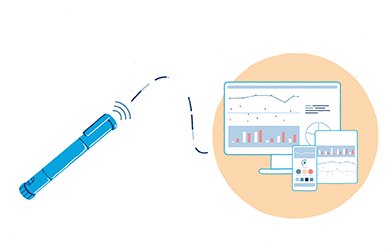
What I wish I knew when I was diagnosed: Part 2
With so many different diabetes technology options available at our fingertips today, Type 1 campaigner Nick Cahm continues to look back on how he managed his diabetes from diagnosis
Technology has made life easier in many ways, including managing diabetes. With lots of options available, it's crucial for people with diabetes to know what's best for them. We talked to Nick Cahm, a Type 1 diabetes advocate, about his journey and the importance of understanding diabetes management choice.
This article reflects the experience, views and opinions of Nick Cahm, and should not be interpreted as being a representation of a wider group of people with diabetes.
On first receiving a diagnosis of diabetes, your first thoughts might not be “what technology is available to me?”. It is more likely to be feelings of sadness, anger and fear of the unknown. I know that when I was diagnosed in 2007, I knew almost nothing about diabetes. I didn’t know how to manage the condition and I didn’t know what the future held. In fact, I didn’t even know what I didn’t know, but needed to know! However, from the very first tentative steps into the world of managing diabetes, I began to understand that there are a few key elements in achieving successful management of diabetes.
I created this model:
Illustration drawn by Nick Cahm denoting the four key elements of achieving, in his opinion, successful diabetes management – support, technology, motivation and education.
Without any one of those factors, it can be difficult or even impossible to manage diabetes effectively1,2. Focusing on technology, the factors are interlinked. Technology can undoubtedly help motivation; technology is nothing without education and knowledge; getting to grips with new technology requires support, which can be from medical professionals or via peer support. On leaving the hospital clinic back in 2007, I perhaps had one of those elements sorted motivation. The rest were still to be addressed, some of them not for nearly ten years.
It can be mistakenly thought that the very latest innovation just by itself will result in better control of diabetes just on its own. But the link between technology and education is vital, and what suits one person, will not necessarily suit another. With innovation there is a requirement to improve knowledge via education. The Covid-19 pandemic has undoubtedly accelerated progress towards online learning platforms facilitated by a wide range of organisations and stakeholders. For too long, education was considered as a classroom-based formal teaching activity. This is changing with opportunities available across many platforms. There is still the challenge of engaging people with this, but ease of access will undoubtedly assist with this.
Technological advance is significant. Speaking with those that have lived with Type 1 for decades, it becomes clear that progress has been significant and incremental, with occasional step-change advances. Technology for diabetes isn’t just the high-end solutions like closed-loop insulin pumps or the most advanced CGM apparatus; it encompasses all elements of the tools that a person living with diabetes needs to use. That includes a long list of items including needles, lancets, insulin, blood glucose test strips, blood glucose monitors and other insulin delivery devices such as smart insulin pens. All of these areas have seen particular improvements in technology in the past twenty years, with step-changes in glucose monitoring and insulin types particularly important.
With all of these advances, it’s important to note that there’s no ‘one size fits all’ with diabetes technology - read more about my personal journey here.
HQ23DI00443

